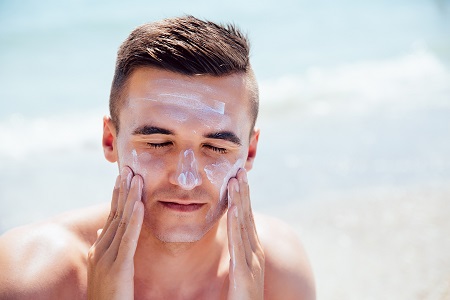Skin cancer is incredibly prevalent in the United States. In fact, one in five adults will develop a form of skin cancer by the time they turn 70 years old.
Skin cancer is especially prevalent among men. Men ages 15-39 are more than twice as likely to die from melanoma as women. After age 50, significantly more men develop melanoma than women. By age 65, men are twice as likely to develop melanoma.
Why is that? One reason could be the differences between men’s skin and women’s skin:
- Men have thicker skin than women.
- Men have less fat under their skin than women.
- Men’s skin has more collagen and elastin.
These characteristics of men’s skin may make it more susceptible to sun damage, according to two separate studies. Research has also shown that women’s skin does a more effective job of repairing sun damage than men’s skin.
Skin cancer symptoms
Symptoms of skin cancer depend on the type of skin cancer you have. Keep a lookout for key warning signs of basal cell carcinoma, squamous cell carcinoma and melanoma.
Basal cell carcinoma is the most common type of skin cancer and occurs in sun-exposed areas like the face and neck and manifests itself as:
- A pearly or waxy bump
- A flat, flesh-colored or brown scar-like lesion
- A bleeding or scabbing sore that heals and returns
Squamous cell carcinoma often appears on sun-exposed areas such as the face, ears or hands and looks like:
- A firm red nodule
- A flat lesion with a scaly, crusted surface
Melanoma is a serious affliction. In men, melanoma makes up 5% of all new cancer cases. Be vigilant in looking out for melanoma, as it can appear in areas of the skin that aren’t exposed to the sun. Look for:
- A large brownish spot with darker speckles
- A mole that changes in color or size and/or that bleeds
- A small lesion with an irregular border and portions that appear red, pink, white, blue or blue-black
- A painful lesion that itches or burns
- Dark lesions on your palms, soles, fingertips or toes, or on mucous membranes lining your mouth, nose, or anus
Skin cancer prevention
Even if you don’t contract skin cancer, sun damage can have other resounding effects on your health, like scarring or early wrinkling of the skin. And regardless of whether or not you’re exhibiting potential symptoms, you should always consult with a medical professional about any changes to your skin that worry you to stay proactive in your prevention.
We also suggest:
- Seeking the shade, especially when the sun is most active
- Wearing a daily sunscreen (even when it’s cloudy) of at least SPF 30
- Wearing a wide-brimmed hat that shields your face
- Avoiding tanning, especially in UV tanning beds
- Examining your body at least once a month
- Making an appointment with a dermatologist once a year
Initial treatment of skin cancer
If your doctor thinks a mark may be cancerous, their first step will likely be to remove the mark. Iowa ENT Center offers a treatment called cryotherapy. Sometimes known as cold therapy, this treatment freezes a pre-cancerous spot with liquid nitrogen.
Stay vigilant
If you’re worried about a suspicious mark on your head or neck, make an appointment with Iowa ENT Center. Call us at 515-223-4368, or fill out our appointment-request form.
